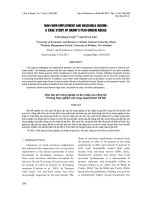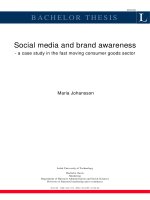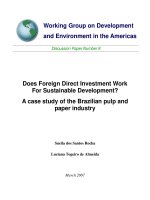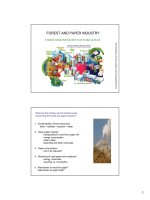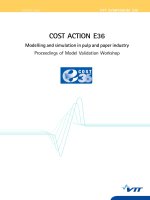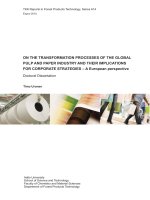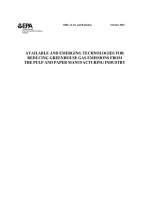CLEANER PRODUCTION AUDIT IN THE PULP AND PAPER INDUSTRY: A CASE STUDY IN VIETNAM doc
Bạn đang xem bản rút gọn của tài liệu. Xem và tải ngay bản đầy đủ của tài liệu tại đây (406.06 KB, 98 trang )
CLEANER PRODUCTION AUDIT IN THE PULP AND PAPER INDUSTRY:
A CASE STUDY IN VIETNAM
by
Vu Tuong Anh
A thesis submitted in partial fulfillment of the requirement for the degree of Master of
Science
Examination Committee : Dr. C. Visvanathan (Chairman)
Mrs. Samorn Muttamara
Dr. Nguyen Thi Kim Oanh
Vu Tuong Anh
Nationality : Vietnamese
Previous Degree : B.Sc. (Chemistry)
Hanoi University
Scholarship Donor : Ecumenical Scholarship Program (ESP)
Asian Institute of Technology
Bangkok, Thailand
August, 1996
ii
ACKNOWLEDGMENT
First of all I would like to express my profound gratitude and sincerest
appreciation to my advisor, Dr. C. Visvanathan for his encouragement, unending support
and valuable advice throughout the study period.
My gratitude is extended to Mrs. Samorn Muttamara and Dr. Nguyen Thi Kim
Oanh for their valuable advice and kindly serving as committee members.
Appreciation is greatly extended to the Ecumenical Scholarship Program (ESP)
for providing financial support for my study at AIT, and to the DANIDA for supporting
research grant.
Sincere thanks are due to Dr. Tran Van Nhan and the Center for Environmental
Science and Technology, Hanoi University of Technology for their help and support
during my field study in Vietnam.
I would like to express my sincere thanks to Dr. Mark Radka of UNEP for
providing necessary information and sharing his experience with me.
My thanks is extended to all staff in the Technical Department of the Van Diem
mill for their help in my field study in the mill.
I would like to thank all faculty, staff and friends of EEP (SERD) at AIT for their
help and cooperation.
Finally, I wish to express my extreme gratefulness to my beloved parents and my
brother for their unending love and encouragement. My sincere thanks is extended to my
husband for his helpfulness, encouragement and moral support during my research
period. I would like to dedicate this piece of work to my beloved parents.
iii
ABSTRACT
Van Diem Paper Mill is a small integrated paper mill that uses bagasse and waste
paper as raw material. The mill manufactures carton board, cover paper, pupil note-book
cover. It was found that upsets and spills occurred frequently as a result of the old
process. The production capacity was found to be 9 tons/day when the mill was running
normally.
Water balance, material balance and energy balance were drawn for the mill. The
water consumption on an overall basis was found to be 376 m
3
per ton of product. The
suspended solid (SS) in the wastewater was 431.8 kg/ton of product. The fiber loss from
the paper machines was considerable with the value of 20.8%. The total of SS and SS70
(parameter used to assess the fiber loss of a paper mill) discharged to the Red river was
369.7 kg/ton and 211.7 kg/ton respectively.
The high concentration of alkaline vapour (0.187 mg/L) in the digestor plant was
a severe source of air pollution in the mill.
The cleaner production opportunities for the mill were studied. Stream
segregation with black liquor collection could reduce pollution load. Good-housekeeping
was especially recommended such as repairing all leakage, keeping taps closed when
they are not in use and cleaning rolls in paper machines.
TABLE OF CONTENTS
CHAPTER TITLE PAGE
Title Page i
Acknowledgment ii
Abstract iii
Table of Contents iv
List of Figures v
List of Tables vi
List of Illustration vii
I. INTRODUCTION
1
1.1 General 1
1.2 Objective 2
1.3 Scope and Limitation of the Study 2
II. LITERATURE REVIEW 3
2.1 General Production Process of Pulp and Paper Industry 3
2.2 Source of Water Pollution and Its Characteristic 10
2.3 Environmental Problem from Pulping Processes 11
2.4 Raw Material for Pulping 12
2.5 Cleaner Production for Small Pulp and Paper Mills 15
2.6 An Overview of the Pulp and Paper Industry in Vietnam and Related
Environmental Issues 16
2.7 Bench Marks in Pulp and Paper Industry 17
III. BACKGROUND INFORMATION OF THE RESEARCH SITE
3.1 General Information 19
3.2 Production Processing 19
3.3 Existing Water Supplied 22
3.4 Existing Wastewater System 22
3.5 Existing Fiber Recovery Unit 26
3.6 Working Environment and Environmental Issues of the Mill 26
3.7 Energy Consumption 26
IV. METHODOLOGY
4.1 Study Program 30
4.2 Data Collection 30
4.3 Inplant Monitoring 30
4.4 Material Balance and Energy Balance 30
4.5 Water Balance 30
4.5.1 Water Supplied Measurement 30
4.5.2 Wastewater Measurement 31
4.5.3 Sampling 32
4.5.4 Water and Wastewater Characterization 33
4.6 Fiber Recovery Unit Study 33
4.7 Physical Agents in Working Environment
4.7.1 Noise Measurement 33
4.7.2 Particulate Matter 36
V RESULTS AND DISCUSSIONS
5.1 Bench Mark of Pulp and Paper Mill 38
5.1.1 Raw Water Used in the Pulp and Paper Mill 38
5.1.2 Wastewater from Production Process 39
5.1.3 Energy Consumption of the Mill 40
5.2 Waste Auditing of Pulp and Paper Mill 40
5.2.1 Unit Operation of the Mill 40
5.2.2 Water Consumption 42
5.2.3 Accounting for Total Wastewater 44
5.2.4 Evaluating Material Balance 48
5.2.5 Summary 52
5.3 Energy Auditing of the Mill 53
5.3.1 Energy Consumption 53
5.3.2 Summary 54
5.4 Fiber Recovery Unit Study 54
5.4.1 Wastewater Quality and Fiber Recovery Efficiency
54
5.4.2 Determination of Settleable Solid of the Effluent 55
5.5 Noise and Air Pollution in the Work Environment 56
5.5.1 Noise 57
5.5.2 Particulate Matter 55
5.6 Identification for Cleaner Production Oppotunities 58
5.6.1 Causes of Waste Generation 58
5.6.2 Cleaner Production Oppotunities 59
5.7 Options of Cleaner Production Opportunities 60
IV CONCLUSIONS AND RECOMMENDATIONS
6.1 Water and Energy of the Mill 64
6.2 Noise and Air Pollution in the Mill 65
6.3 Recommendation on Cleaner Production Opportunities 65
REFERENCES
APPENDICES
LIST OF FIGURES
FIGURE TITLE PAGE
2.1 Simplified Diagram of Pulp and Paper Process 4
2.2 Flowchart of Mechanical Pulping Process 5
2.3 Sulphite Pulping Process 7
2.4 Semichemical Pulping Process 9
2.5 Cleaner Production Techniques 15
3.1 Location of the Van Diem Paper Mill
20
3.2 Layout of the Van Diem Paper Mill 21
3.3 Simplified Diagram of Pulp and Paper Production of the Mill 23
3.4 Pulp Production Diagram of the Mill 24
3.5 Paper Production Diagram of the Mill 25
3.6 Water Supplied System of the Mill 26
3.7 Wastewater Drainage System of the Mill 27
3.8 Steam Distribution System of the Mill 29
4.1 General Methodology Outline
31
4.2 Flowrate Measurement Equipment 32
4.3 Wastewater Sampling Points and Wastewater Flow
Measurement Points 33
4.4 Raw Water Sampling Points and Water Supplied Flow
Measurement Points 34
4.5 Settleable Solid Measurement Using Imhoff Cone 37
4.6 Sound Level Meter Used for Noise Measurement 37
LIST OF TABLES
TABLE TITLE PAGE
2.1 Typical Analytical results for Pulp and Paper Mill Waste 10
2.2 Chemical Composition and Fiber Dimension of Agricultural Residue-based
and Wood Based Raw Material 13
2.3 Wash Filter Loading and Dewatering Properties of Various Sulphate
and Soda Pulp 14
2.4 Bench Marks for Pulp and Paper Production 17
2.5 Wastewater Pollution Load in Agricultural Residue-based Mill 18
4.1 Analytical Parameters, Locations and Methods Used during the Study 35
ix
ABBREVIATION
BL : Black Liquor
BOD : Biochemical Oxygen Demand
COD : Chemical Oxygen Demand
Cond. : Conductivity
CP : Cleaner Production
I : Investment Costs
kg/ton : kg/ton of product
L : Litre
L/s : Litre per second
Lpm : Litre per minute
P : Pay Back Period
PM : Paper Machine
RM : Raw Material Preparation
S : Saving Money
SS : Suspended Solid
SS70 : Suspended Solid (filter 70 µm)
Temp. : Temperature
TS : Total Solid
CHAPTER 1
INTRODUCTION
1. General
Paper is becoming an essential commodity of today’s society. The pulp and paper
industry has been growing with demand of paper. The capita consumption has also been
steadily increasing over the world.
The pulp and paper industry is considered as one of the major potential sources
of pollution in the environment. There are two segments, pulping and paper making in
the manufacturing process. Pulping is the major source of environmental pollution.
Black liquor from chemical pulping processes is the most significant and troublesome
source of pollution. Effluent from these pulping processes contains chemicals which are
known to cause damage to the flora and fauna . Also, bottom deposits of lignin cellulose
material near the point of discharge undergoes slow decomposition that leads to
depletion of dissolved oxygen in the receiving body.
The raw materials for pulp production are those containing cellulose fibers. They
are divided into two main types: wood and non-wood materials. Environmental problems
on a global scale of deforestation is occurring. Therefore, using non-wood fiber material
for paper production is encouraging. Although non-wood fibrous raw material based
account for only about 5% of the raw material for pulp and paper manufacture today it is
one of the major sources of fibrous raw material for many developing countries
(GIERTZ, 1993). Agricultural residues are the most important raw materials of non-
wood group that were used in agriculture countries.
In developing countries, the small scale mills are more popular than large ones.
Small scale mills usually cause high level of environmental pollution because of
outdated technologies, poor operational and maintenance practices and others. On the
other hand agricultural residues are especially suitable for small scale mills as their raw
materials. However, using agricultural residues satisfies in terms of reducing the burden
on forest wood, it has its adverse environmental impacts in term of pollutant discharge.
Pulp and paper production is an important contributor to the economy of many
nations. In Vietnam, the industry accounted for 1.8 per cent of the output value of the
manufacturing sectors. Despite its increase in production capacity, it has not met the
domestic consumption demand.
The utilization of sugar cane bagasse as raw material for the pulp and paper
industry needs some attention in sugar cane producing countries such as Vienam. It
contributes to reducing deforestation as well as using by-product from the sugar industry.
However, small paper mills using sugar cane bagasse as raw material have caused
environmental pollution at high levels.
-2-
Therefore, cleaner production study in the small mill using sugar cane bagasse as
raw material for pulp and paper production is useful in terms of economy as well as
environmental protection aspect.
An essential step in implementing cleaner production is waste audit as it gives a
comprehensive look at production process to facilitate the understanding of material
flows and to show pollution sources within the process. A waste audit points out the
points specific area where pollution reduction may be achieved and helps to implement
maximum resource optimization and improved process performance (UNEP/IEO and
UNIDO,1991).
This study investigated the current environmental status of a pulp and paper mill
in small scale in Vietnam and recommended cleaner production practices for the mill.
2. Objectives
The objectives of the study are:
1. To identify and evaluate sources and causes of waste generation of the pulping
and paper making processes with a view to find out the extent of all
environmental pollution problems, major focus on waste stream.
2. To determine the quantity and characteristic of wastewater discharges in pulp and
paper mill which use non-wood material as raw material.
3. To identify possibilities to conserve water and to minimize pollution load.
4. To recommend cleaner production practices to the mill.
3. Scope and Limitation of the Study
This study was limited only to a small scale pulp and paper industry using sugar
cane bagasse as raw material.
Initial investigation of environmental status of the mill included water, air and
noise pollution but the major task focused on wastewater.
The study on implementing cleaner production was concentrated on process
effluent reduction and recovery as well as recycling rather than the process modification.
CHAPTER II
LITERATURE REVIEW
2.1 General Production Process of Pulp and Paper Industry
The manufacture of paper can be divided into two phases: the pulping and the
paper making. In the pulping phase the cellulose raw material must be processed to free
fibers with suitable properties for paper product. The paper making is the continuous
process consisting of forming slurried pulp in sheet form then pressing, drying,
calendering.
The simplified flow diagram of pulp and paper production process is shown in
Figure 2.1.
2.1.1 Pulping
The pulping process can be divided into three categories: chemical pulping,
mechanical pulping, and semi-chemical pulping (combination of two above categories).
Mechanical pulping
Mechanical pulp is produced by grinding or shredding the wood or non-wood
materials to free the fibers. In addition heat and pressure may be applied to assist the
process. Mechanical pulping provides low grade pulps with high color and short fibers,
but with a high yield converting 95% of the wood into pulp and produces minimal on-site
air pollution and relatively water loads (ANONYMOUS 1981). The mechanical pulping
process is presented in Figure 2.2.
1) Stone Groundwood Pulping
The first grinders were built by Voith in 1852. In this method logs of wood are
ground against a stone wheel to produce clumps of fiber. Stone groundwood does have
some favourable characteristics : low energy costs and high fines content which is
desirable for printing characteristics.
2) Refiner pulping
The first attempt to use disc refiners to produce mechanical pulps was
made in the 1950's. This demonstrated that it was possible to produce pulp which was
stronger than stone groundwood (Mc CUBBIN, 1984). Thermo-mechanical pulping
(TMP) process was developed.
-4-
This technique involves presteaming of chips for a short period, typically about
three minutes, at a 110-130
o
C and 150-210kPa and then performing the first stage of
refining under pressure (Mc CUBBIN, 1984).
3) Pressurized Groundwood
Pressurized Groundwood (PGW) is a relatively new development. It is similar to
the stone groundwood process but logs is ground under pressure. Generally speaking, the
production of mechanical pulps has been limited to the use of soft woods preferably
spruce, balsam and hemlock and , to a lesser extent, jack pine(due to a lower pulp
quality). TMP has pulp yield of approximately 94% and the published data on BOD
discharge varies from about 15 kg/t to 35 kg/t.(MCCUBBIN, 1984)
Mechanical pulping provides a short pulp fiber due to the considerable fiber
damage caused by grinding.
Chemical pulping
Chemical pulping is done by digesting to free fibers from the wood chips, non-
wood materials such as bamboo, straw, grass, cotton, in chemical solutions that help to
dissolve the lignin binding material. Pulp yield is normally in the range of 35 to 57% and
about 95% of the lignin is removed in pulping (MCCUBBIN, 1983). Chemical pulps may
be subdivided into Kraft (sulphate), sulphite, semi-chemical and soda.
Soda pulping
The soda pulping was the first chemical process applied in pulp manufacture. In
the process, sodium hydroxide is used as cooking liquor with adding a mixture of soda
ash (Na
2
CO
3
) and lime Ca(OH)
2
to the digester. This process is most suitable for
agricultural residues pulping (PALMER et al., 1983).
Sulphite Pulping Process
The sulphite pulping process is one of the major pulping methods. This process is
most suitable for non-resinous softwood. In this method, the fibre-binding lignin is
softened and dissolved to a considerable extent in a solution containing dissolved SO
2
,
hydrogen sulphite ions with pH value between 1.5-12. Depending on the cooking degree,
the yield varies from 45 to 65%, but normally the yield is about 50% for standard non-
bleached pulps. If the pulp is bleached, another 4 to 5% of the original wood weight may
be lost in the process. (ANONYMOUS, 1982). An advantage of the kraft pulping
process is the possibility of recovering both process chemicals and the heat content of the
dissolved lignin. One drawback is that the process results in pulps with a high kappa
number which thus require bleaching for many applications. The sulphite pulping
process is illustrated in Figure 2.3.
3/ Kraft Pulping Process
-5-
Kraft pulping, first used in 1879, is a modification of the caustic soda process in
that sodium sulphite (Na
2
S) is added to the cooking liquor. The presence of caustic soda
in the cooking liquor is suitable for use of practically all wood species. Sodium sulphate
is on
duty of buffering, that digestion can be implemented at a lower OH
-
ion concentration.
Thus damage to the fibers is reduced and high strength pulps is produced (UNEP, 1977)
4/ Semi-chemical Pulping
In this process the pulping of wood raw material pulp is obtained by a series of
chemical and mechanical wood treatments. The main semi-chemical pulping process are:
• Neutral sulphite, in which the active chemical is sodium sulphite, sufficient alkali
( usually sodium carbonate or sodium bicarbonate) is used to keep the
digestion liquor alkaline.
• Cold soda, in which chips are soaked for several hours in sodium hydroxide at
atmospheric pressure without heating.
The simplified flow sheet of semi-chemical pulping process is presented in Figure 2.4.
5/ Other processes
According to PALMER (1983) recognizing the difficulties of using established
processes on a small scale, a number of alternative processes are being developed which
are claimed to be specially suitable for small-scale operation either because they are
non-polluting (in at least one case it is claimed that digestion liquor can be used
as fertilizer) or because the recovery process is relatively simple. Examples of these
processes are:
• Ammonia-based pulping.
• Oxygen (air) and alkali processes.
• Universal process (acid based).
2.1.2 Paper making
In the paper making process pulp is converted into paper. Normally, the process
consists of four main steps: stock preparation, sheet preparation, water removal and sheet
finishing. Pulp in the stock is heated and mixed. Some different chemicals and fillers
like alum, clay, and starch are added to the pulp stock for enhancement of certain paper
properties. Next, the pulp is evenly distributed over a travelling belt of fine wire
screening, and carried to rolls. A small portion of the water contained in the pulp passes
through the screen, while the longer fiber are laid down on the wire , pressed through a
series of rolls then air dried in a steam-heated dryer section. After drying, the sheet may
be surface treated and then finished. A considerable portion of the fine fibers and some
-6-
fillers also pass through the screen wire with water . Because of its colour, this
wastewater is called "white water". The main sources of waste from paper mills are
beaters and paper machines.
2.2 Sources of Water Pollution and Its Characteristics
The pulp and paper industry is one of the largest water- using industries, not only
in terms of the volume specific water use, but also in terms of the volume of output.
The sources of the wastewater in the pulp and paper industry come from chipping,
pulping, rinsing, chemical recovery, bleaching and paper making process ( STOLL,
1995).
NEMEROW (1978) reviewed the major origins and characteristics of wastes from
different pulping processes and paper making. Since different types of pulping processes
generate somewhat different wastes, each type should be considered separately . Typical
analytical results of different types of pulp and paper wastes are presented in Table 2.1
Table 2.1 Typical analytical results for pulp and paper mill waste
(NEMEROW, 1978)
Product
BOD, mg/L Suspended solid, mg/L
Pulp
Groundwood
Soda
Sulphate (kraft)
Sulphite
Miscellaneous paper
No bleach
With bleach
Paperboard
Strawboard
Deinking used paper
645
110
123
443
19
24
121
965
300
1720
452
156
660
1790
The characteristics of pulp and paper industry effluents causing environmental
problem are suspended solid, representing undissolved substances including lignin and
hemicellulose, which are not biodegradable (persistent) and high COD in the wastewater.
-7-
Toxicity of pulp and paper mill effluent may be caused by sulphur compounds
introduced into the pulping process, dissolved organic compounds of the raw materials,
resin and fatty acids and some cases heavy metal ( which are used for wood preservation
or raising paper quality). More recent questions have been raised regarding chlorinated
dioxins, formed during the bleaching process, that effect water quality for human
consumption and other purposes (GELLMAN, 1988).
Colour and turbidity of effluents cause aesthetic problems. Colour of the pulp and
paper industry's wastewater is caused mainly by lignins of the wood as well as in some
cases by dye.
2.3 Environmental Problems from Pulp and Paper Production
Preparation of Fibrous Raw Material
There are two types of fibrous raw materials: wood and non-wood material. The
wood material preparation at mill site include weighing, storage, washing, debarking and
chipping. The debarking method and equipment is determined by the type of wood, the
pulping process, the pulp quality and the debarking capacity. The major source of water
pollution from the wood preparation is debarking, specially when wet debarking is used.
The effluent contains large amounts of dissolved as well as suspended pollutants. In
general, wood has to be washed before chipping to prevent damaging the knives by sand
and other impurities. Therefore, the wastewater from the process contains coarse
materials.
For the non-wood material (such as bagasse, bamboo, reed, or cereal and rice
straw) preparation, the major source of water pollution is crushing and chipping
(bamboo), depithing (bagasse), wet cleaning (rice straw).
Pulping
In this stage, either mechanical or chemical methods are used to produce fibers.
In the chemical method , fibrous raw material is treated with chemical cooking liquor
which used to dissolve most of lignin and liberate the fibers. The effluent is called black
liquor containing lignin and hemicellulose as well as toxic waste material like dimethyl
sulphite, methyl mercaptan etc. The wastewater is highly polluted with brown color and
high COD. Bottom deposits of lignin cellulosic materials near the discharge point will
lead to a DO depletion at the discharge point.
Washing and Screening
From an environmental point of view the pulp rinsing after the cooking is one of
the most important operations in a pulp mill. The rinsing operation aims to separate pulp
fiber from spent cooking liquor that contains inorganic cooking chemicals and organic
substances dissolved from the fibrous raw materials. A thorough washing, that leaves a
low residue of black liquor in the washed pulp is also decisive for the amount of polluting
discharges from the following process department, i.e. screening and bleaching.
-8-
The screening operation which remove knots, shives, and other impurities is
usually integrated in the washing system. The water used for dilution in the screens is
discharged together with fiber losses and dissolved substance(PER ALSEFELT et al.,
1991).
Bleaching
In order to obtain good properties like white and strong paper it must remove
remaining lignin and resinous bark as well as knot particles. This process is called
bleaching. The effluent of kraft pulp mill affects spinal deformation in fourhorn sculpin.
The changes of skeletal composition and strength show a disturbance in the metabolism
and onto genetic growth of fish (BENGTSSON, 1988).
SODERGREN (1993) indicated that there are two general types of bleaching
sequences: C-E-H-D-E-D and oxygen delignification O-D-EPO-D-EP-D (O=oxygen,
C=chlorine, D=chlorine dioxide, H=hypochlorite, E=alkaline extraction, P=hydrogen
peroxide). The effluent from a bleaching plant contains large amount of lignin-related
chlorinated compounds which have a negative impact on environment in receiving area
and further more they are "persistent"/ or degrade very slowly. The effluent of bleached
pulp affects the diversity, biomass and distribution of fish, invertebrates and plants
(SODERGREN et al.1989)
BONSOR et al. (1988) reported that kraft mill effluent interacts with a low DO
(dissolved oxygen) content and produces synergism effect.
2.4 Raw Material for Pulp Production
The fibrous raw materials can be classified as follows:
Wood
• Softwood (spruce, pine, fir, hemlock etc.)
• Hardwood (birch, eucalyptus, mixed tropical hardwoods etc.)
Non-wood
• Agricultural and other residues such as straw from cereals, rice and sorghum
as well as sugar cane bagasse
• Naturally grown plants such as bamboo, reeds, papyrus, esparto and other
grasses
• Crops primary grown for their fibers content such as juite, hemp, kenaft,
ramie, flax (bast or stem fibers); abaca or Manila hemp, sisal (leaf fibers);
cotton (seed hair)
Of these, bagasse, reed, bamboo, cereal (wheat, rye) and rice straw are the most
important non-wood fiber raw materials for paper making.
-9-
Non-wood raw materials
The chemical composition does not differ much between different types of non-
wood fiber and the lignin content is largely the same as that of hardwood. The cellulose
content and the fibers length vary relatively little between the wood based and non-wood
based raw materials. However, the ash content of agricultural residues is much higher
than that of the wood based raw materials.
Chemical characteristics and fiber dimension of different raw materials including
hardwood (common raw material for large mills) and non-wood (raw material for small
mills) are given in Table 2.2
Table 2.2 Chemical Composition and Fiber Dimension of Agricultural Residues and
Wood Based Raw Materials (PANNEERSELVAM, 1988)
Raw Material
Cellulose
(Alpha) (%)
Lignin
(%)
Ash
(%)
Fiber Length
(Av. mm)
Fiber Diameter
(Av. µm)
Rice straw
Wheat straw
Bagasse
Reeds
Hardwoods
Softwoods
28-41
30-40
26-39
33-43
35-49
41-44
10-17
16-20
19-22
18-23
22-32
25-28
14-22
4-11
1-5
3-6
0.5-3
0.4
1.5
1.5
1.6
1.2
1.0
3.5
9
13
20
12
17-32
35-40
Non-wood fibers are easy to be delignified by chemical pulping. It is noted that
non-wood fiber are delignified much faster than wood. This can be explained by the
reason of the more open structure of the fiber tissue. (UNEP,1986)
GIERTZ (1993) reported that the most widely used pulping method for non-wood
raw materials are the soda and the sulphate processes. These processes have a
relatively short cooking cycle either applied in continuous or in a batch system. This
means the digester volume can be rather small.
Bagasse fairly resembles hardwood in chemical composition and this is reflected
in the yield which is largely the same as that of hardwood but not in cooking time.
Generally speaking, further processing in the fiber production line such as screening,
bleaching and drying is largely the same for the non-wood fibers as for wood.
a) Advantages of non-wood pulp:
Non-wood raw materials are cheap.
-10-
Non-wood fibers are delignified much faster than wood. The material is
satisfactorily delignified and the pulp obtained is of high quality and can be easily
bleached to an acceptable brightness .
The cooking time of non-wood raw material is shorter than that of the hardwood.
Therefore the bagasse cooking time is very short with low alkali requirements and results
in a pulp with low yield.
b) Disadvantages of non-wood pulping
- Preparation of fibrous raw material
The problem lies in the preparation of fibrous raw material including collection,
transportation, and storage. These are bulky material. One important thing to note is its
seasonal delivery. They might deteriorate during storage. The dust loads in the handling,
storage and cleaning of bagasse, bamboo and straw is high.
-Washing
The design of washing equipment has to be more elaborate than for wood pulps
due to a slow drainage property of non-wood pulps. This is illustrated in the Table 2.3
Table 2.4 Wash filter loadings and dewatering properties of various sulphate and
soda pulps (UNEP, 1986)
Pulp type
Wash filter loading
t
100/m
2
d
Freeness*
o
SR
Softwood
Hardwood
birch
eucalyptus globulus
Bagasse
Bamboo
Rice straw
Wheat straw
5-7
4-6
6-9
2-4
4
1.5-2
0.5-2
12-13
15-16
20-25
14-16
40
30
o
SR is degree Schopper Riegler (unit for pulp freeness which represents drainage
of property of fiber)
* Assuming chemical pulp yields and no refining
-11-
Chemical recovery
In comparison with wood pulping, chemical recovery in non-wood pulping have
some drawbacks:
♦ High content of silica which dissolve in the black liquor as silicate that lead to
serious scaling during evaporation. The concentrations of silica in different raw
materials are reviewed: rice straw (10-13%), bamboo (4-6% ), soft wood (0.8-2%)
(UNEP 1981).
♦ High viscosity
♦ Low heat value because of lower lignin content and higher carbohydrates content
2.5 Cleaner Production for Small Non-wood Pulp and Paper Mill
2.5.1 Cleaner Production
United Nations Environment Program defines Cleaner Production as following
(NATIONAL PRODUCTIVITY COUNCIL NPC, 1996)
Cleaner Production is the continuous application of an intergrated preventive
environmental strategy to processes and products to reduce risk to humans and the
environment.
-For production process, Cleaner Production includes conserving raw materials
and energy, eliminating toxic raw materials, and reducing the quantity and toxicity of all
emissions and wastes before they leave a process.
Cleaner Production techniques are shown in Figure 2.5
CLEANER PRODUCTION
TECHNIQUES
RECYCLING
PRODUCT
MODIFICATION
SOURCE
REDUCTION
GOOD
HOUSEKEEPING
PROCESS
CHANGE
Figure 2.5 Cleaner Production Techniques (NPC, 1995)
-12-
The very essential step in implementing cleaner production is waste audit. This
management tool has been developed to respond to the new environmental management
philosophy that of waste prevention and reduction.
In UNEP(1991) it is reported that a waste audit enable one to take a
comprehensive look at a site or process to facilitate one's understanding of material flows
and to focus one's attention on areas where waste reduction and therefore cost saving is
possible.
2.5.2 Cleaner Production for Small Non-wood Pulp and Paper Mill
It is noted that in the case of small pulp mills a chemical recovery system is
uneconomical.
PANNERSELVAM, (1988) suggested certain simple pollution abatement
measures for small mills. Such internal process modifications are less capital intensive
and the small mills can more easily afford them, particularly when the associated
benefits are considered.
Water conservation is performed by using intermittent high pressure, high volume
showers or continuous high pressure, low volume showers for felt shower. Felt showers
provide water for paper machine at the time paper mat is sent to press rolls. It is
necessary to develop appropriate inexpensive fiber recovery systems to promote the fiber
recovery among small mill.
It is uneconomical for the small mill to run a conventional chemical recovery
system. Thus it is essential to develop an alternative simple inexpensive chemical
recovery method. In tropical countries with very high solar intensity, the feasibility of
separating the black liquor and increasing its solid content in a series of solar
evaporation ponds should be considered (PANNERSELVAM, 1988)
2.6 An Overview on the Pulp and Paper Industry in Vietnam and Related
Environmental Issues
2.6.1 Overview on Pulp and Paper Industry
The number of pulp and paper mill and designed capacity of existing enterprise
establishment in Vietnam are presented in Table 1- and Table -2 Appendix A,
respectively.
The largest mill is Vinh Phu Paper Union (BAPACO) with a production capacity of
55,000 tons per year (t/y). The two intergrated pulp and paper mills Tan Mai
(COGIVINA) and COGIDO with production capacities of 45,000 t/y and 15,000 t/y
respectively are ranked after BAFACO. The other mill are small with capacity varying
from 300 t/y to 10,000 t/y. At present, there has 9 key-mills which produce 65% of total
paper production of the industry. The general information of these mill is shown in Table
-3 Appendix A.
-13-
The major pulping process in Vietnam is the soda. The soda pulping process is
mainly applied for mills which use non-wood as raw material. This method is applied to
produce more than 50% of the pulp production. The pulping methods used in BAPACO,
COGIVINA and COGIDO are Kraft, thermo-mechanical and modified soda (cooking
liquor is sodium adding 1% of sulphur) respectively.
SANH (1996) reported that pulp and paper industry is still in small scale with
capacity of 3 kg per capita per year. In 1995, pulp and paper production reached 120,000
tons and 200,000 tons respectively. Paper demand has increased in Vietnam. It is
estimated that paper demand will be around 500,000-700,000 tons by the year 2000 (an
increasing of 2.5-3 times).
2.6.2 The Related Environmental Issues
Most of the pulp and paper mills in Vietnam are in small scale. It is uneconomical
if chemical recovery systems are applied in small mill (with capacity less than 50,000
t/y). Therefore, all the pulp and paper mills have no chemical recovery system except for
BAPACO. Pollution control facilities for the industry are very poor. There are some
environmental researches on pulp and paper industry in Vietnam. TRUNG (1990) studied
the reuse of black liquor from pulp production to produce construction material
(concrete). This kind of additive makes stress intensity of cement increasing to 1.5-3
times and reduces 5-10% of water consumption in concrete production.
KIM OANH (1994) did a wastewater management in BAPACO. The study
showed that the effluent of this intergrated kraft pulp and paper mill is mildly acute toxic.
A monitoring program for environmental audit of the pulp and paper mill was proposed.
DAN (1990) carried out experiments on wastewater treatment of Long Binh pulp
and paper mill. Physical treatment method (sedimentation), physico-chemical method
(neutralization, coagulation, absorbed filtration) and biological method (water hyacinth
pond) were studied. The results showed that 80-90% of can be removed by settling
method, color and turbidity can be decreased by coagulation method with alum coagulant
(140 mg/L) and 90% of COD and 80% of lignin was removed in water hyacinth pond.
2.7 Bench Marks in Pulp and Paper Industry
WHO, (1993) indicated a bench mark in order to assess the waste discharge of
pulp, paper and paperboard manufacturing as in Table 2.4
Table 2.4 Bench mark for Pulp and Paper Production (WHO, 1993)
BOD
5
TSS
Manufacture Unit (U) Waste Volume
m
3
/U
Kg/U kg/U
Pulp mills
Wood Pulp
Mechanical
tn of product
tn of product
tn of product
-14-
Sulfate(Kraft)
Sulfite
Semi chemical
tn of product
tn of product
tn of product
61.3
92.4
47
31
130
27
18
26
12.5
Paper mills
Newsprint paper
Kraft coarse paper
Cigarette paper
Paperboard/Simple
finish
Graphic paper
tn of product
tn of product
tn of product
tn of product
tn of product
190
125
100
200
7.5
5.5
11.5
15
10.5
2
10.5
37.5
30
6.5
Wastewater pollution load of pulp mill section, paper machine and combined
these of agicultural residue-based mill is presented in Table 2.7. The total requirement of
raw water is about 200-300 m
3
.
Table 2.5: Wastewater Pollution Load in agricutural residue-based mill
(CHANDAK et al., 1993)
Parameter
Pulp mill
section
Paper machine Factory
combined
Wastewater flow rate (m
3
/t)
BOD (kg/t)
COD (kg/t)
TSS (kg/t)
TS (kg/t)
110-168
128-210
705-1140
118-262
872-1292
60-80
27-41
80-140
61-109
205-394
162-230
161-245
865-1215
192-362
993-1408
CHAPTER III
BACKGROUND INFORMATION OF THE RESEARCH SITE
3.1 General Information
Van Diem Paper Mill is a small paper mill. It was established in 1962 at Phu
Minh district Ha Tay province. The mill is bordered by the Red river dike in the East and
a Sugar Mill in the South. Figure 3.1 and Figure A-1 in Appendix A shown the location
of Van Diem Paper mill. The layout of the mill is shown in Figure 3.2. It shows the
location of office, digestor house, depithing house, paper processing, finishing, fiber
recovery unit, sedimentation unit for water supply and bagasse storage ground area.
Products of the mill are carton board, cover paper and pupil note-book cover. All
of them are unbleached products. The designed capacity is 3000 tons product per year. In
1995 the capacity was 2700 tons of paper.
The mill uses sugar cane residue bagasse as raw material based for pulp
production. Bagasse is bought from neighbour Sugar Mill and transported to bagasse
storage ground of the mill through a belt conveyer.
The mill has 300 employees. Generally, production activities are carried out in 3
shifts (24 hours per day). During the month of December, the mill is closed for machine
maintenance.
3.2 Production Processing
Production process of the mill is changed depending on raw material state. The
main raw material of the mill is bagasse which is supplied seasonally. During the sugar
cane season, bagasse is transported from the sugar cane mill on belt conveyers to
material storage site of the pulp mill. It has moisture content of 50%. Bagasse is
incubated in ponds to reduce chemical consumed in cooking process. Rest of the bagasse
is heap up in trapezium form on the ground when the ponds are full. Therefore, there are
two periods of production. From January to May (sugar cane season) the mill uses
bagasse which is not incubated. The bagasse is depithed before cooking. In the rest time,
the incubated bagasse is used without depithing. Incubated bagasse consumes less caustic
soda than unincubated bagasse. In the first period, bagasse is fed into depithing machine
where it is cut into small pieces. The piths are carried away by air blower into a pipe
going outside.
The depithed bagasse is transported to the spherical digestors, where caustic soda
solution (white liquor ) with a concentration of 120g/L, water and steam is added. The
digestors are turn round with a speed of 2.5 circles per minute. The delignifying is carried
out at approximately 110-125
o
C and at a pressure of 2.5 atm. The cooking is performed
by a batch process and the cooking time is 5 hours. Charging and discharging takes
-20-
Railway
Figure 3.1 Location of the Van Diem Paper Mill
